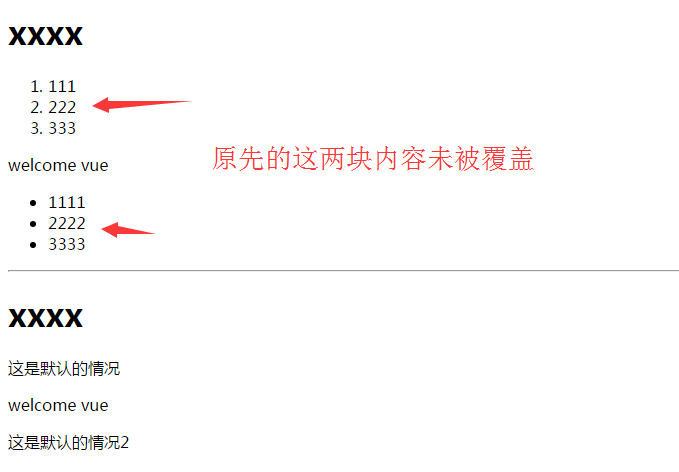vue教程3-05 vue组件数据传递
一、vue默认情况下,子组件也没法访问父组件数据
<!DOCTYPE html>
<html lang="en">
<head>
<meta charset="UTF-8">
<title>Document</title>
<script src="bower_components/vue/dist/vue.js"></script>
<style>
</style>
</head>
<body>
<div id="box">
<aaa>
</aaa>
</div>
<script>
var vm=new Vue({
el:'#box',
data:{
a:'aaa'
},
components:{
'aaa':{
data(){
return {
msg:'我是父组件的数据'
}
},
template:'<h2>我是aaa组件</h2><bbb></bbb>',
components:{
'bbb':{
template:'<h3>我是bbb组件->{{msg}}</h3>'//这里是子组件,是访问不到父组件的数据msg
}
}
}
}
});
</script>
</body>
</html>

二、数据传递
组件数据传递: √ 1. 子组件获取父组件data 在调用子组件: <bbb :m="数据"></bbb> 子组件之内: props:['m','myMsg'] props:{ 'm':String, 'myMsg':Number } 2. 父级获取子级数据 *子组件把自己的数据,发送到父级 vm.$emit(事件名,数据); v-on: @
1、子组件获取父组件data
方法一:
<!DOCTYPE html>
<html lang="en">
<head>
<meta charset="UTF-8">
<title>Document</title>
<script src="bower_components/vue/dist/vue.js"></script>
<style>
</style>
</head>
<body>
<div id="box">
<aaa></aaa>
</div>
<template id="aaa">
<h1>11111</h1>
<bbb :mmm="msg2" :my-msg="msg"></bbb>
</template>
<script>
var vm=new Vue({
el:'#box',
data:{
a:'aaa'
},
components:{
'aaa':{
data(){
return {
msg:111,
msg2:'我是父组件的数据'
}
},
template:'#aaa',
components:{
'bbb':{
props:['mmm','myMsg'],//my-msg在这里要变成驼峰命名法
template:'<h3>我是bbb组件->{{mmm}} <br> {{myMsg}}</h3>'
}
}
}
}
});
</script>
</body>
</html>
方法二:
<!DOCTYPE html>
<html lang="en">
<head>
<meta charset="UTF-8">
<title>Document</title>
<script src="bower_components/vue/dist/vue.js"></script>
<style>
</style>
</head>
<body>
<div id="box">
<aaa></aaa>
</div>
<template id="aaa">
<h1>11111</h1>
<bbb :mmm="msg2" :my-msg="msg"></bbb>
</template>
<script>
var vm=new Vue({
el:'#box',
data:{
a:'aaa'
},
components:{
'aaa':{
data(){
return {
msg:111,
msg2:'我是父组件的数据'
}
},
template:'#aaa',
components:{
'bbb':{
props:{
'm':String,//注明数据类型
'myMsg':Number
},
template:'<h3>我是bbb组件->{{mmm}} <br> {{myMsg}}</h3>'
}
}
}
}
});
</script>
</body>
</html>
2、 父级获取子级数据
方法一:
<!DOCTYPE html>
<html lang="en">
<head>
<meta charset="UTF-8">
<title>Document</title>
<script src="bower_components/vue/dist/vue.js"></script>
<style>
</style>
</head>
<body>
<div id="box">
<aaa></aaa>
</div>
<template id="aaa">
<span>我是父级 -> {{msg}}</span>
<bbb @child-msg="get"></bbb>
</template>
<template id="bbb">
<h3>子组件-</h3>
<input type="button" value="send" @click="send">
</template>
<script>
var vm=new Vue({
el:'#box',
data:{
a:'aaa'
},
components:{
'aaa':{
data(){
return {
msg:'我是父组件的数据'
}
},
template:'#aaa',
methods:{
get(msg){
// alert(msg);
this.msg=msg;
}
},
components:{
'bbb':{
data(){
return {
a:'我是子组件的数据'
}
},
template:'#bbb',
methods:{
send(){
this.$emit('child-msg',this.a);
}
}
}
}
}
}
});
</script>
</body>
</html>
注意:
vm.$dispatch(事件名,数据) 子级向父级发送数据
vm.$broadcast(事件名,数据) 父级向子级广播数据
配合: event:{}
在vue2.0里面已经,报废了
slot:位置、槽口
作用: 占个位置,不覆盖原先的内容
类似ng里面 transclude (指令)
<!DOCTYPE html>
<html lang="en">
<head>
<meta charset="UTF-8">
<title>Document</title>
<script src="bower_components/vue/dist/vue.js"></script>
<style>
</style>
</head>
<body>
<div id="box">
<aaa>
<ul slot="ul-slot">
<li>1111</li>
<li>2222</li>
<li>3333</li>
</ul>
<ol slot="ol-slot">
<li>111</li>
<li>222</li>
<li>333</li>
</ol>
</aaa>
<hr>
<aaa>
</aaa>
</div>
<template id="aaa">
<h1>xxxx</h1>
<slot name="ol-slot">这是默认的情况</slot>
<p>welcome vue</p>
<slot name="ul-slot">这是默认的情况2</slot>
</template>
<script>
var vm=new Vue({
el:'#box',
data:{
a:'aaa'
},
components:{
'aaa':{
template:'#aaa'
}
}
});
</script>
</body>
</html>
效果图:

vue-> SPA应用,单页面应用 vue-router路由
vue-> SPA应用,单页面应用 vue-router路由 vue-resouce 交互 vue-router 路由 路由:根据不同url地址,出现不同效果 该课程配套用 0.7.13版本 vue-router 主页 home 新闻页 news html: <a v-link="{path:'/home'}">主页</a> 跳转链接 展示内容: <router-view></router-view> js: //1. 准备一个根组件 var App=Vue.extend(); //2. Home News组件都准备 var Home=Vue.extend({ template:'<h3>我是主页</h3>' }); var News=Vue.extend({ template:'<h3>我是新闻</h3>' }); //3. 准备路由 var router=new VueRouter(); //4. 关联 router.map({ 'home':{ component:Home }, 'news':{ component:News } }); //5. 启动路由 router.start(App,'#box'); 跳转: router.redirect({ ‘/’:'/home' });
下载vue-router:

vue-router路由:
<!DOCTYPE html>
<html lang="en">
<head>
<meta charset="UTF-8">
<title>Document</title>
<script src="bower_components/vue/dist/vue.js"></script>
<script src="bower_components/vue-router/dist/vue-router.js"></script>
<style>
</style>
</head>
<body>
<div id="box">
<ul>
<li>
<a v-link="{path:'/home'}">主页</a>
</li>
<li>
<a v-link="{path:'/news'}">新闻</a>
</li>
</ul>
<div>
<router-view></router-view>
</div>
</div>
<script>
//1. 准备一个根组件
var App=Vue.extend();
//2. Home News组件都准备
var Home=Vue.extend({
template:'<h3>我是主页</h3>'
});
var News=Vue.extend({
template:'<h3>我是新闻</h3>'
});
//3. 准备路由
var router=new VueRouter();
//4. 关联
router.map({
'home':{
component:Home
},
'news':{
component:News
}
});
//5. 启动路由
router.start(App,'#box');
</script>
</body>
</html>
跳转:
<!DOCTYPE html>
<html lang="en">
<head>
<meta charset="UTF-8">
<title>Document</title>
<script src="bower_components/vue/dist/vue.js"></script>
<script src="bower_components/vue-router/dist/vue-router.js"></script>
<style>
</style>
</head>
<body>
<div id="box">
<ul>
<li>
<a v-link="{path:'/home'}">主页</a>
</li>
<li>
<a v-link="{path:'/news'}">新闻</a>
</li>
</ul>
<div>
<router-view></router-view>
</div>
</div>
<script>
//1. 准备一个根组件
var App=Vue.extend();
//2. Home News组件都准备
var Home=Vue.extend({
template:'<h3>我是主页</h3>'
});
var News=Vue.extend({
template:'<h3>我是新闻</h3>'
});
//3. 准备路由
var router=new VueRouter();
//4. 关联
router.map({
'home':{
component:Home
},
'news':{
component:News
}
});
//5. 启动路由
router.start(App,'#box');
//6. 跳转
router.redirect({
'/':'home' //访问根目录时,跳转到/home
});
</script>
</body>
</html>